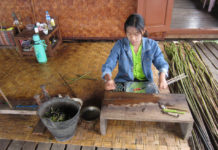
A wide variety of baskets and plaited objects are produced during lulls in the agricultural cycle in Sabah where plant resources and raw materials are abundant, accessible and inexpensive. Nearly all indigenous communities, from the coast to the remote interior, make and use one or more types of basketry objects from leaves, stems, spathes, bark and roots available in the vicinity or harvested or purchased further afield. The basketry techniques of weaving, plaiting, coiling and twining allow flexible and creative use of these different plant materials to craft these objects, many similar in form, appearance and construction, for domestic use and trade.
Back-carrier baskets, ranging from large, circular carriers to smaller, flatter bags for utilitarian and ceremonial needs, are the most iconic. For remote interior farming communities with no road access, large back-carrier baskets made of palm spathes lashed together using rattan twine and shoulder straps of woven rattan or bark cloth, are vital to transport goods, agricultural produce, hunting spoils and personal belongings, allowing villagers hands-free mobility on rugged terrain. While many baskets are not identified with a particular district or ethnic group, their names distinguish the design, shape and materials used, such as the popular wakid, made of split bamboo, with a narrow circular base that widens at the mouth.

Hats made of rattan, bamboo, plant fibre and twine are another mainstay of indigenous farming life. Each district and community produces and uses its own variation of these conical hats, distinguished from one another by shape (mostly circular but occasionally hexagonal), design, motifs and materials. More elaborate and finely crafted hats are usually reserved for ceremonial and ritual purposes, such as the siung, plaited on its three sides with traditional motifs in black and red.
Increasing loss of natural habitats and the consequent scarcity of natural fibres has led to some use of synthetic materials or a combination of natural and synthetic for basketry and plaited objects while maintaining traditional forms and functions. But growing tourist demand for Sabah’s hand-crafted objects has spurred various cultural, tourism and rural development agencies to revitalise and improve production standards through training, exhibitions and state and district cultural festivals.




